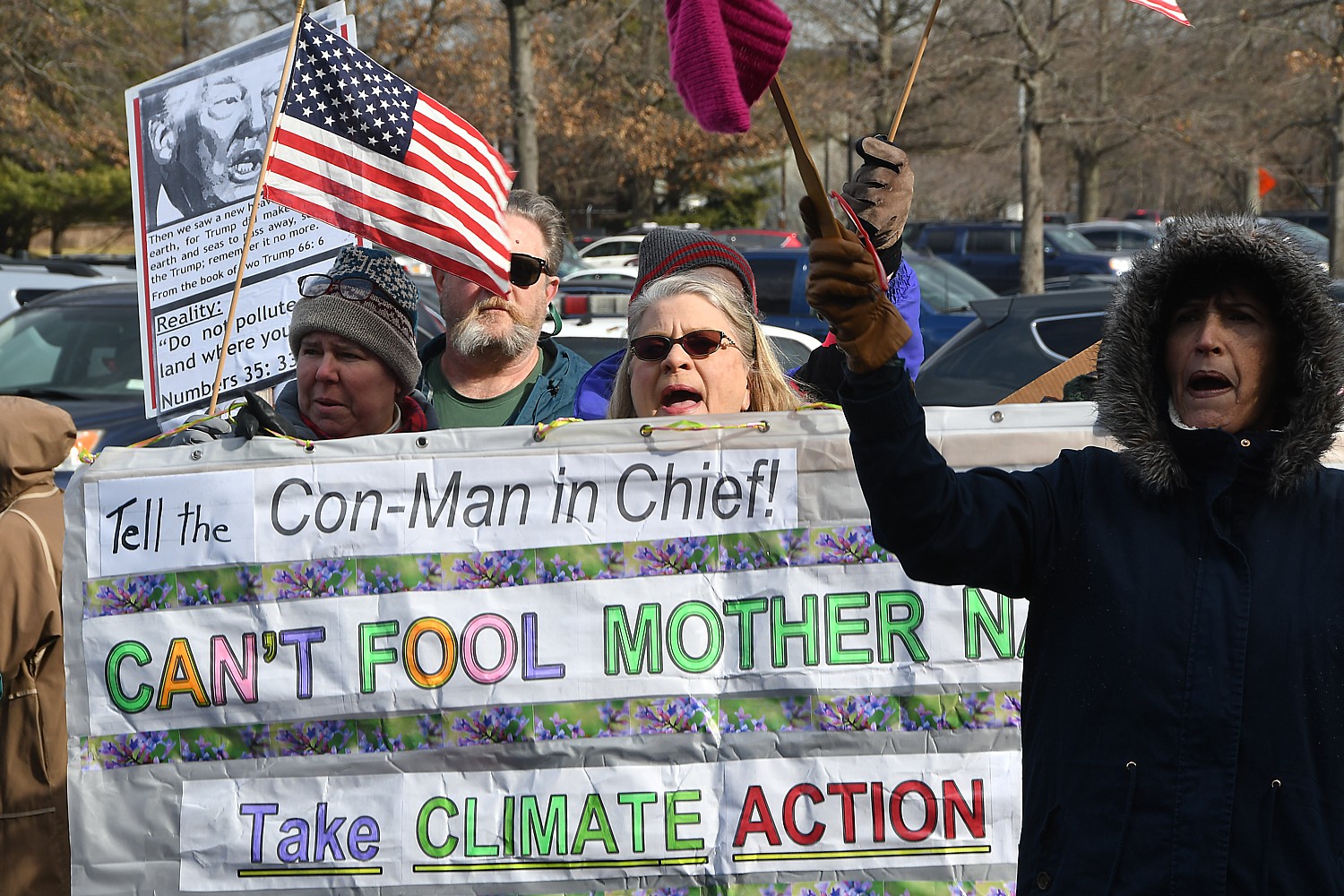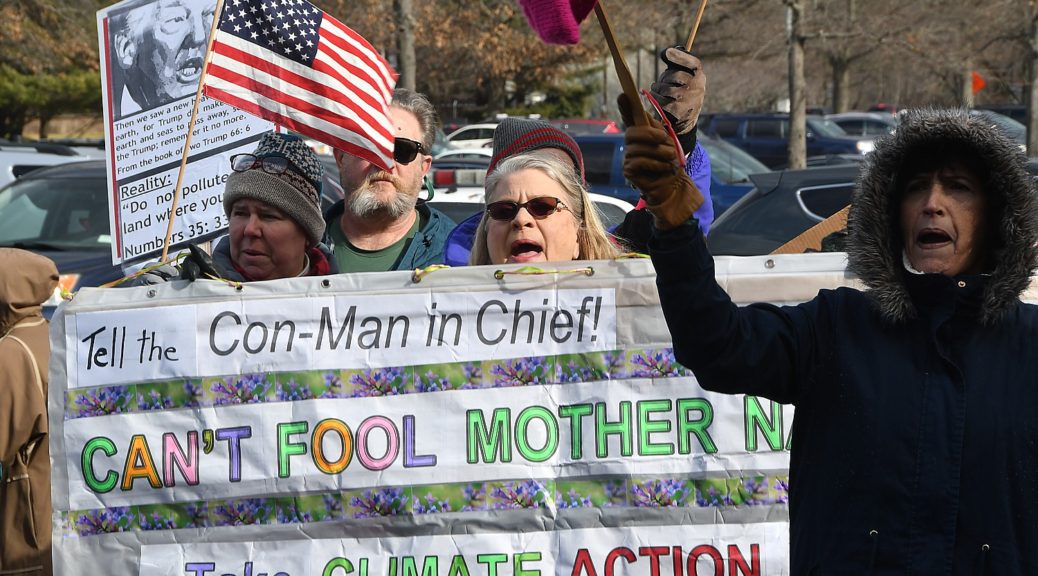
By Karen Rubin, News & Photo Features
Here’s the backdrop for the People’s Climate March, which took place April 29, on the 100th day of Trump’s occupation of the Oval Office: the administration withdrew its challenge in the court paving the way for Obama’s signature Clean Power Plan, regulating coal-powered plants and the essence for how the US would meet its commitment under the Paris Climate Agreement, to be overturned by EPA Administrator Scott Pruitt, who as Oklahoma AG, was one of the states challenging the plan in court.
And, two days before the climate march, Trump signed an Executive Order, effectively opening up all the protected marine sanctuaries through to the Continental shelf to new oil and gas drilling and exploitation. What is more, Trump’s goal is not just under the banner of American First Energy Independence, he sees the US as the major new supplier of fossil fuel energy to “allies”, which would necessitate building and converting infrastructure designed for import to export.
Most of the so-called “accomplishments” Trump has touted for his first 100 days have been reflexively overturning and reversing President Obama’s climate actions and environmental protections (with anti-women’s health and reproductive rights thrown in). It’s now okay for mining companies to throw their toxic waste into streams.
At the signing “ceremony” for the “Executive Order on an America-First Offshore Energy Strategy,” Trump declared, “This is a great day for American workers and families, and today we’re unleashing American energy and clearing the way for thousands and thousands of high-paying American energy jobs. Our country is blessed with incredible natural resources, including abundant offshore oil and natural gas reserves. But the federal government has kept 94 percent of these offshore areas closed for exploration and production. And when they say closed, they mean closed.
“This deprives our country of potentially thousands and thousands of jobs and billions of dollars in wealth. I pledged to take action, and today I am keeping that promise.
“This executive order starts the process of opening offshore areas to job-creating energy exploration. It reverses the previous administration’s Arctic leasing ban. So hear that: It reverses the previous administration’s Arctic leasing ban, and directs Secretary Zinke to allow responsible development of offshore areas that will bring revenue to our Treasury and jobs to our workers. (Applause.) In addition, Secretary Zinke will be reconsidering burdensome regulations that slow job creation.
“Finally, this order will enable better scientific study of our offshore resources and research that has blocked everything from happening for far too long. You notice it doesn’t get blocked for other nations. It only gets blocked for our nation.
“Renewed offshore energy production will reduce the cost of energy, create countless good jobs, and make America more secure and far more energy independent. This action is another historic step toward future development and future — with a future — a real future. And I have to say that’s a real future with greater prosperity and security for all Americans, which is what we want,” Trump said during the signing ceremony.”
The day before, at a press availability, Interior Secretary Ryan Zinke said, “94% of outer continental shelf is off limits for possible development – as of Mar 1 2007, only 16 million acres on the outer continental shelf out of 1.7 billion acres were under lease for oil & gas development; more than 97% of current leases are in Gulf of Mexico.”
In 2008, revenues of $18 billion came from offshore; in 2016, that amount dropped $15 billion to $2.8 billion, he noted.
Zinke added, “We like export to other countries – energy security is not only to provide for ourselves but supply allies – oil and gas exports to Asian basin is all part of it. A lot requires infrastructure – this country set up for importing energy, looking at ways to reverse that – a lot is infrastructure, we are behind. We want to supply our allies with affordable energy.”
Asked whether melting ice caps in the Arctic Circle has made for new opportunities (and have any companies specifically asked for leases), he said he had not thought about climate change shifting geographical requirements.
EarthJustice greeted the EO with promises of a lawsuit: “We won’t let this administration destroy these essential protections at a time when they’re so critically needed. In response, we’re preparing to file a lawsuit immediately to challenge this order,” writes Trip Van Noppen, President.
“Tomorrow, people from Washington, D.C., to Oakland, CA, will march in the streets to show this new administration that if the next four years are anything like the first 100 days, we’ll be here, fighting back every step of the way.”
The Peoples Climate March on Saturday, April 29 will begin near the Capitol, travel up Pennsylvania Avenue, and then surround the entire White House Grounds from 15th Street in the East to 17th Street in the West, and Pennsylvania Avenue in the North to Constitution Avenue in the South. The march will close with a post march rally, concert and gathering at the Washington Monument.
Events also are being held in hundreds of communities around the country.
For more information on the April 29th Peoples Climate Mobilization, visit peoplesclimate.org
Follow us on Twitter @Peoples_Climate and
Facebook http://www.facebook.com/peoplesclimate
Here is the White House Fact Sheet touting their America First Energy Independence Plan:
President Donald J. Trump to Open Up America’s Energy Potential
“I am going to lift the restrictions on American energy, and allow this wealth to pour into our communities.” – Donald J. Trump
AMERICA’S ENERGY RESOURCES ARE LOCKED AWAY: Under the previous administrations, America’s offshore resources were blocked from responsible development.
- Ninety-four percent of the U.S. Outer Continental Shelf’s (OCS’s) 1.7 billion acres are either off-limits to or not considered for oil and gas exploration and development under the current (2017-2022) leasing program.
o Days before leaving office on January 17, 2017, the Obama Administration approved the latest schedule for oil and gas lease sales that would last for five years until 2022.
o There are hundreds of millions of acres of federal waters in the Arctic Ocean, Atlantic Ocean, and Gulf of Mexico.
- The OCS is expected to contain 90 billion barrels of undiscovered technically recoverable oil and 327 trillion cubic feet of undiscovered technically recoverable natural gas.
- In FY 2016, Federal revenues from the OCS were $2.8 billion; the actual sales value of the oil and gas resources was $26 billion and generated $55 billion in total spending in the economy. These expenditures supported approximately 315,000 American jobs.
- Alaska has seen a number of nearby OCS areas closed off to development and now has the second highest unemployment in the country, as its resource sectors, particularly oil and gas, have lost thousands of jobs.
o At least one energy company has announced it would withdraw from all but one of its OCS leases in Alaska because of uncertain federal regulations.
- Revenue to the Federal Government from leasing the OCS has fallen by over 80 percent, from $18 billion in 2008 to $2.8 billion in 2016. On average, OCS energy development generates $10-12 billion annually.
FREEING AMERICA’S ENERGY POTENTIAL: President Donald J. Trump is removing restrictions on the OCS that locked away America’s energy potential.
- President Trump signed an Executive Order today to direct the Secretary of Interior and Secretary of Commerce to take action on OCS restrictions.
- The Secretary of the Interior will review areas closed off by the current five-year plan for sale of oil and gas leases in the OCS, without disrupting scheduled lease sales. These planning areas include:
o Western and Central Gulf of Mexico
o Chukchi Sea
o Beaufort Sea
o Cook Inlet
o Mid and South Atlantic
- The Secretary of the Interior will review four rules and regulations put in place last year that could reduce exploration and development in the OCS. These include:
o Notice to Lessees and Operators of Federal Oil and Gas, and Sulfur Leases, and Holders of Pipeline Right-of-Way and Right-of-Use and Easement Grants in the Outer Continental Shelf
o Oil and Gas and Sulfur Operations in the Outer Continental Shelf-Blowout Preventer Systems and Well Control
o Air Quality Control, Reporting, and Compliance
o Oil and Gas and Sulfur Operations on the Outer Continental Shelf—Requirements for Exploratory Drilling on the Arctic Outer Continental Shelf
- The Secretary of Commerce is directed to refrain from designating or expanding National Marine Sanctuaries unless the proposal includes “a timely, full accounting from the Department of the Interior of any energy or mineral resource potential”—including offshore energy from wind, oil, natural gas, and other sources—within the designated area and the potential impact the proposed designation or expansion will have on the development of those resources.
- The Secretary of Commerce and the Secretary of the Interior will work together to develop a streamlined permitting approach for privately funded seismic data research and collection to expeditiously determine the offshore resource potential of the United States.
FOLLOWING THROUGH ON HIS PROMISE TO THE AMERICAN PEOPLE: President Trump is following through on the energy development policies he promised to the American people.
- Then-Candidate Trump:
o “We need an America-First energy plan. This means opening Federal lands for oil and gas production; opening offshore areas; and revoking policies that are imposing unnecessary restrictions on innovative new exploration technologies.”
______________________
© 2017 News & Photo Features Syndicate, a division of Workstyles, Inc. All rights reserved. For editorial feature and photo information, go to www.news-photos-features.com, email editor@news-photos-features.com. Blogging at www.dailykos.com/blogs/NewsPhotosFeatures. ‘Like’ us on facebook.com/NewsPhotoFeatures, Tweet @KarenBRubin


